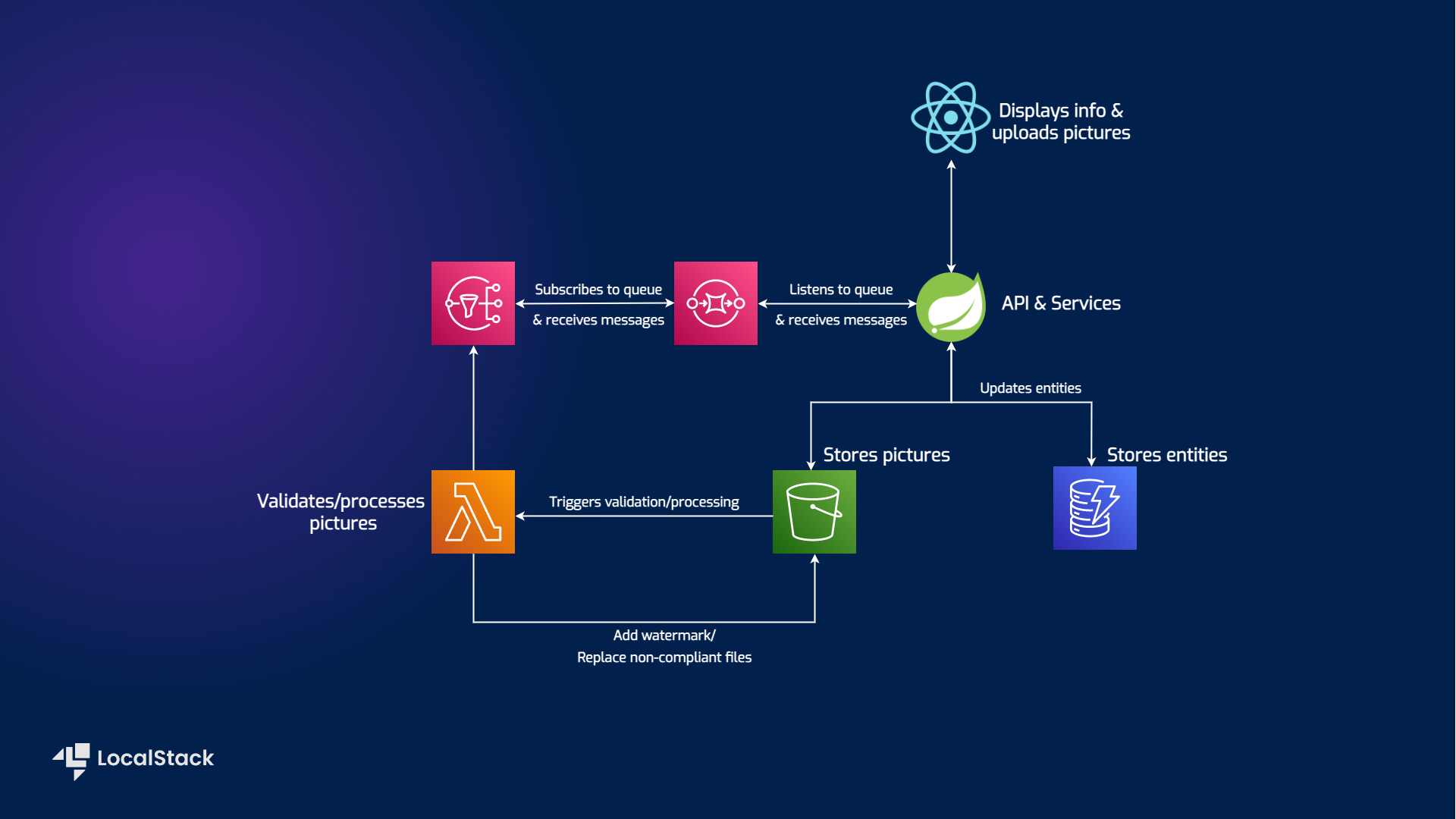| Environment |   |
|---|---|
| Services | Amazon S3, Lambda, DynamoDB, SNS, SQS |
| Integrations | AWS SDK, Terraform |
| Categories | Spring Boot, S3 Trigger |
| Level | Intermediate |
| Works on | LocalStack v3 |
The Terraform configuration file now randomly generates names for the bucket, in order to avoid conflicts at a global scale on AWS. This name shall be written out to a properties file, which the app will pick up and use for the S3 client. Furthermore, the name is also passed as an environment variable to the Lambda function by Terraform, so there's no need to worry about managing it.
The purpose of this demo is to highlight the ease of integrating LocalStack with Testcontainers and using Terraform to provision the necessary test infrastructure. The original demo: https://github.com/localstack-samples/sample-shipment-list-demo-lambda-dynamodb-s3.
- Maven 3.8.5 & Java 17
- Docker - for running LocalStack
shipment-list-demo is a Spring Boot application dealing with CRUD operations a person can execute on a bunch of shipments that they're allowed to view - think of it like the Post app. The demo consists of a backend and a frontend implementation, using React to display the information. The AWS services involved are:
- S3 for storing pictures
- DynamoDB for the entities
- Lambda function that will validate the pictures, apply a watermark and replace non-compliant files.
- SNS that receives update notifications
- SQS that subscribes to a topic and delivers the messages to the Spring Boot app
There are several tests available, testing different scenarios, to assure good integration between services. Ideally we want to focus on the workflows and make sure they run correctly:
Since the main infrastructure provisioning tool is Terraform, it would only be natural to use the same file to create resources for testing purposes. This insures the environment is set up as expected and there are no discrepancies between what we test and what we expect to see in production.
Step into the shipment-picture-lambda-validator module and run mvn clean package shade:shade.
This will create an uber-jar by packaging all its dependencies. We'll need this to pass to the container to build the Lambda
function.
LocalStack is now supporting Terraform config files to be used as init hooks.
This means that the container will automatically recognize and run the main.tf file placed in the ready.d folder.
@Container
protected static LocalStackContainer localStack =
new LocalStackContainer(DockerImageName.parse("localstack/localstack-pro:latest"))
.withEnv("LAMBDA_REMOVE_CONTAINERS", "1")
.withEnv("EXTENSION_AUTO_INSTALL", "localstack-extension-terraform-init")
.withEnv("LOCALSTACK_AUTH_TOKEN", System.getenv("LOCALSTACK_AUTH_TOKEN"))
.withFileSystemBind("./lambda/shipment-picture-lambda-validator.jar",
"/etc/localstack/init/ready.d/lambda/shipment-picture-lambda-validator.jar")
.withFileSystemBind("./terraform",
"/etc/localstack/init/ready.d")
.withStartupTimeout(Duration.of(4, ChronoUnit.MINUTES))
.withEnv("DEBUG", "1");We pass the contents of the terraform directory to the container, as it needs more than just a singular TF file.
By mounting the entire folder, we can run the tests multiple times without having to download the AWS provider every time on the init operation.
You can simply run the following command in the root folder.
LOCALSTACK_AUTH_TOKEN=<your_auth_token> mvn -Dtest=ShipmentServiceIntegrationTest testAdditionally, you can also use your IDE (such as IntelliJ IDEA) to have a better interface of running your tests.
We appreciate your interest in contributing to our project and are always looking for new ways to improve the developer experience. We welcome feedback, bug reports, and even feature ideas from the community. Please refer to the contributing file for more details on how to get started.


